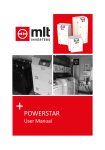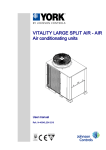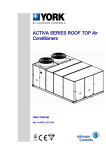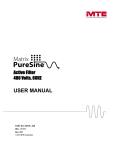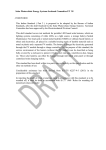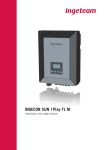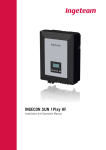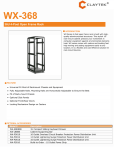Download User Manual - MLT Inverters
Transcript
+ OASIS User Manual © 2015 MLT Inverters 2nd Edition June 2015 PAGE 2 OASIS USER MANUAL Oasis Series User Manual Table of Contents 1. Introduction .......................................................................................................................... 7 1.1 Warnings and Cautions ................................................................................................ 7 1.2 Contacting MLT Inverters ............................................................................................ 8 1.2.1 Product Support................................................................................................... 8 1.2.2 Contact Details..................................................................................................... 8 1.2.3 Telephone ............................................................................................................ 8 1.3 System Specifications................................................................................................... 9 1.3.1 System Ratings ..................................................................................................... 9 1.3.2 AC Input................................................................................................................ 9 1.3.3 DC Specifications.................................................................................................. 9 Connectors ................................................................................................................... 10 1.3.4 Efficiency ............................................................................................................ 10 1.3.5 General Specifications ....................................................................................... 10 1.3.6 Climatic Conditions ............................................................................................ 10 1.3.7 Operator Panel .................................................................................................. 10 1.3.8 Altitude Derating ............................................................................................... 11 1.4 System Description .................................................................................................... 12 1.4.1 Typical Off-grid or Self Consumption Application ............................................ 12 1.4.2 Typical Grid-tied Application ............................................................................. 12 1.4.3 Basic Generator or Load Control ...................................................................... 12 2. Advanced Features ............................................................................................................. 14 2.1 Battery Cycling............................................................................................................ 14 2.2 Auxiliary Relay control ............................................................................................... 14 2.2.1 Battery Critical ................................................................................................... 14 2.2.2 High Load ........................................................................................................... 14 2.2.3 Overload............................................................................................................. 14 OASIS USER MANUAL PAGE 3 3. 2.3 Load Sense .................................................................................................................. 15 2.4 MLT Bridge Communications (Optional Add-on) ..................................................... 15 Mounting and Electrical Connections ............................................................................... 16 3.1 Installing the Oasis inverter ....................................................................................... 16 3.1.1 Selecting a suitable location.............................................................................. 16 3.1.2 Mounting ........................................................................................................... 16 3.1.3 Making the electrical connections .................................................................... 17 3.1.4 Setting up the Oasis ........................................................................................... 19 3.1.5 Powering up the Oasis....................................................................................... 19 3.1.6 Powering down the Oasis ................................................................................. 20 4. 5. Inverter Operation Indicators ............................................................................................ 22 4.1 Inverter Status ............................................................................................................ 22 4.2 Battery Status ............................................................................................................. 22 4.3 Source Status .............................................................................................................. 22 4.4 Load Status ................................................................................................................. 22 4.5 Special Combinations ................................................................................................. 22 Interface .............................................................................................................................. 23 5.1 On/Off Button ............................................................................................................ 23 5.2 System Icons ............................................................................................................... 23 5.3 Dashboard .................................................................................................................. 23 5.4 Control Panel .............................................................................................................. 24 5.5 Graphing and Logs...................................................................................................... 25 5.5.1 Source Graphs.................................................................................................... 25 5.5.2 Load Graphs ....................................................................................................... 25 5.5.3 Battery Graphs ................................................................................................... 26 5.5.4 Event logs ........................................................................................................... 26 5.6 Settings ....................................................................................................................... 28 5.6.1 Settings Menu .................................................................................................... 28 5.6.2 Setup Alarms ...................................................................................................... 28 PAGE 4 OASIS USER MANUAL 5.6.3 Date & Time ....................................................................................................... 29 5.6.4 Relay Control...................................................................................................... 30 5.6.5 Battery Cycle ...................................................................................................... 31 6. Configuration ...................................................................................................................... 33 6.1 DIP Switch configuration............................................................................................ 33 6.2 Connecting an external AC source ............................................................................ 33 6.2.1 Preparation ........................................................................................................ 33 6.2.2 Installing a Generator ........................................................................................ 33 7. Configuration Switches ...................................................................................................... 34 7.1 DIP Switch Table ......................................................................................................... 34 7.1.1 Description of DIP functionality ........................................................................ 34 8. About Batteries ................................................................................................................... 36 8.1 General ....................................................................................................................... 36 8.1.1 Sealed Batteries ................................................................................................. 36 8.1.2 Deep Cycle Batteries.......................................................................................... 36 8.2 Battery Bank Location ................................................................................................ 36 8.3 Maintenance .............................................................................................................. 37 8.4 Replacing a Battery .................................................................................................... 37 8.5 Battery Bank Size........................................................................................................ 37 8.6 Battery charging ......................................................................................................... 38 8.6.1 Battery Charging Stages .................................................................................... 38 8.7 Battery Low Levels ..................................................................................................... 39 8.8 Battery Cells Voltage .................................................................................................. 39 8.9 Battery charger settings ............................................................................................. 39 8.9.1 Battery charging current ................................................................................... 39 8.9.2 Battery charging voltages.................................................................................. 40 9. About Solar Panels.............................................................................................................. 41 9.1 Introduction................................................................................................................ 41 9.2 Using a Solar System with the Oasis.......................................................................... 41 OASIS USER MANUAL PAGE 5 10. Trouble Shooting ................................................................................................................ 42 10.1 Faults ........................................................................................................................... 42 10.2 Typical Problems ........................................................................................................ 42 10.2.1 Why does the Oasis not connect to a running generator? ................... 42 10.2.2 Why does the generator connect and then immediately drop out?.... 42 10.2.3 Why didn’t I get the usual capacity from my storage batteries? .......... 42 10.2.4 Why doesn’t my Oasis ‘wake up’ when I switch on a load?.................. 43 11. Glossary ............................................................................................................................... 44 12. Appendix: Operational Flow Charts .................................................................................. 45 12.1 Flag Based Logic Flow Chart....................................................................................... 45 12.2 Battery Critical Flow Chart ......................................................................................... 46 12.3 Battery Level Flow Chart ............................................................................................ 47 12.4 Battery Cycling Flow Chart......................................................................................... 48 12.5 Overload ..................................................................................................................... 49 12.6 Relays .......................................................................................................................... 50 12.7 Warning Condition ..................................................................................................... 51 12.8 Fault Condition ........................................................................................................... 52 Figures Figure 1: De-rating the Oasis inverter output power at high altitude ........................................ 11 Figure 2: Identifying parts of the Oasis......................................................................................... 13 Figure 3: Wall mounting................................................................................................................ 17 Figure 4: AC Input/output Connections on the Oasis.................................................................. 19 Figure 5: DC cables ........................................................................................................................ 20 Figure 6: Oasis DC connections..................................................................................................... 21 PAGE 6 OASIS USER MANUAL 1. Introduction 1.1 Warnings and Cautions A safety instruction (message) includes a hazard alert symbol and a signal word, WARNING or CAUTION. Each signal word has the following meaning: HIGH VOLTAGE: This symbol indicates the presence of a high voltage. It calls your attention to items or operations that could be dangerous to yourself or others operating this equipment. Read the message and follow the instructions carefully. WARNING: Indicates a potentially hazardous situation which, if not avoided, can result in serious injury or death. CAUTION: Indicates a potentially hazardous situation which, if not avoided, can result in minor to moderate injury, or serious damage to the product. The situation described in the CAUTION may, if not avoided, lead to serious results. GENERAL WARNINGS DANGER OF ELECTRIC SHOCK. There are no user serviceable parts inside the inverter. DO NOT attempt to make repairs or alterations to the unit. WARNING: This equipment should be installed, adjusted, and serviced by qualified electrical maintenance personnel familiar with the construction and operation of the equipment and the hazards involved. Failure to observe this precaution could result in personal injury. GENERAL CAUTIONS CAUTION: Always wear personal protective equipment (protective clothing, gloves, and safety boots) while performing an installation or maintenance, to avoid the danger of injuries. CAUTION: Proper grounds, disconnecting devices, e.g. bypass boxes and other safety devices and their location are the responsibility of the user and are not provided by MLT Inverters. CAUTION: Do not cover the device or store it in a small space - always keep it well ventilated and well away from flammable gases or powders. Components in the device could potentially cause a small electric spark that could ignite flammable gas or powders. Flammable gases are created by batteries and can become a hazard in poorly ventilated spaces. CAUTION: For indoor use only and MUST be installed in a dry area free from conductive liquids or conductive debris. If part of the inverter becomes submerged in water look for a safe way to isolate it at the distribution board and if possible at the batteries. OASIS USER MANUAL PAGE 7 1.2 Contacting MLT Inverters 1.2.1 Product Support When contacting Product Support via telephone, email or fax please provide the following information for the fastest possible service: Type of Inverter Serial number Battery type Battery bank capacity Battery bank voltage A description of the error Note that the serial number is available on the serial plate that is attached to the bottom of the machine inside the cover. 1.2.2 Contact Details Telephone: +27 (0) 21 201 1335 Email: [email protected] Address: 103 Garfield Road Kenilworth 7708 Cape Town South Africa 1.2.3 Telephone You can reach technical support by telephone directly Monday to Friday between 08h00 and 17h00 (GMT +2 hours). Queries outside of these hours should be directed to [email protected] and will be answered at the earliest opportunity. When contacting technical support, please ensure that you have the information listed above available. PAGE 8 OASIS USER MANUAL 1.3 System Specifications 1.3.1 System Ratings Oasis 324 Oasis 436 / 448 Oasis 636 / 648 Rated Voltage / Frequency 1ø / 230 V / 50 Hz 1ø / 230 V / 50 Hz 1ø / 230 V / 50 Hz Rated Output Power 3 kVA 4 kVA 6 kVA Rated Output Current 13 A (40 A with AC source) 17 A (40 A with AC source) 26 A (60 A with AC source) Maximum output current 19 A (for 30s), 26 A (for 2s), 40 A (with AC source) 26 A (for 30s), 34 A (for 2s), 40 A (with AC source) 39 A (for 30s), 52 A (for 2s), 60 A (with AC source) THD V (at rated power) <5% <5% <5% Protection Surge, Overload, Short circuit, Over temperature, Reverse power, Low / High battery voltage Changeover time 1.3.2 Less than 30ms changeover time after source failure. Some devices might lose power with changeover. AC Input Input Voltage Range 185 .. 250 V 185 .. 250 V 185 .. 250 V Input Frequency Range 42 .. 65 Hz 42 .. 65 Hz 42 .. 65 Hz Rated Input Current 40 A 40 A 60 A 36 / 48 V 1.3.3 DC Specifications Battery Voltage (Nominal) 24 V 36 / 48 V Charging Voltage 28.2 / 29.4 V 42.3 / 44.1 V (36 V) and 56.4 / 58.8 V (48 V) Maximum Charging Current 25 / 50 A 25 / 50 A (36 V) & 20 / 40 A (48 V) Battery Technology 30 / 60 A (36 V) & 25 / 50 A (48 V) Lead-Acid, Li-Ion¹ ¹ Contact MLT Inverters for details on supported Batteries. OASIS USER MANUAL PAGE 9 Connectors Rated Voltage / Frequency 1ø / 230 V / 50 Hz 1ø / 230 V / 50 Hz 1ø / 230 V / 50 Hz Rated Output Power 3 kVA 4 kVA 6 kVA 1.3.4 Efficiency Oasis 324 Oasis 436 / 448 Oasis 636 / 648 Efficiency Up to 94 % Up to 94 % Up to 94 % No Load Power Consumption (On) < 30 W < 35 W < 40 W No Load Power Consumption (Load Sense) 5W 6W 6W 1.3.5 General Specifications Mounting Method Wall Mounted Dimensions (W x H x D) 355 x 580 x 210 mm 355 x 580 x 210 mm 380 x 700 x 210 mm IP/NEMA Rating IP20 / NEMA1 IP20 / NEMA1 IP20 / NEMA1 Colour RAL9002 / RAL9011 RAL9002 / RAL9011 RAL9002 / RAL9011 Weight 40 kg 40 kg 60 kg Architecture 1.3.6 Galvanically Isolated, Forced Air Cooling Climatic Conditions Ambient Temperature -5 .. 45 °C Ambient Transport Temperature -25 .. 70 °C Maximum Ambient for Rated Power 40 °C Relative Humidity (Non-Condensing) 5 .. 85 % Maximum Altitude for Rated Power 1000 m above sea level (Power derated for High Altitude) 1.3.7 Operator Panel Display Type PAGE 10 Full Colour Touch Screen 4.3” LCD; 24h logs of source power, load power, battery state of charge and Events OASIS USER MANUAL 1.3.8 Altitude Derating Percentage of rated power vs Altitude Percentage of Rated Power 100 98 96 94 92 90 88 86 84 82 80 0 500 1000 1500 2000 2500 3000 3500 4000 Altititude Above Sea Level in Meters Figure 1: De-rating the Oasis inverter output power at high altitude OASIS USER MANUAL PAGE 11 1.4 System Description The Oasis inverter range offers a cost-effective and reliable solution to the home or farm owner faced with unreliable or no grid electricity supply. The inverter operates at low-voltage DC and is transformer-based, which translates to a robust and safe product that guarantees trusted power in the harshest environments. The Oasis inverter system can be configured in various ways, and some examples are shown below. 1.4.1 Typical Off-grid or Self Consumption Application The Oasis inverter is ideal for off-grid installations where the renewable source of power is fed directly into the batteries. The Oasis converts the battery power into clean AC power that the load can use. The built-in battery charging function allows the use of a backup generator or the grid without the need for external battery chargers. The Oasis can be configured to maximise selfconsumption of renewable power by disconnecting from the grid during specified times, enabling optimal use of all available renewable power. 1.4.2 Typical Grid-tied Application The Oasis inverter will act as a backup supply to provide power from the batteries in the event of a grid failure. Installing a solar PV inverter on the load side will allow efficient use of solar energy and any excess generated power will automatically be used to charge the batteries or be exported to the grid. 1.4.3 Basic Generator or Load Control In off-grid systems, the Oasis inverter can automatically start the generator when the battery voltage is low or an overload occurs. The Oasis synchronises with the generator before connecting the load. When the charge cycle is complete, or when the overload disappears, the Oasis will turn off the generator and transition back to stand-alone mode. The Oasis can also be used to turn on / off specific loads based on low battery voltage or overload. PAGE 12 OASIS USER MANUAL Figure 2: Identifying parts of the Oasis OASIS USER MANUAL PAGE 13 2. Advanced Features 2.1 Battery Cycling The Oasis can be configured to maximise self-consumption of renewable power by disconnecting from the grid or source during specified user determined times, enabling optimal use of all available renewable power. In some cases where peak demand prices are increased, the Oasis can thus be programmed to utilise battery power through these periods. 2.2 Auxiliary Relay control A single, no voltage auxiliary relay can be controlled with three user settings. This relay can be used to control external load relays, a generator or any other simple binary logical circuit you can think of. 2.2.1 Battery Critical If the battery bank is being depleted, with no external recharging, eventually a battery low state will occur. If this continues for long enough a Battery Critical state is reached. When a Battery Critical stage is reached, the auxiliary relay will be engaged. This allows, for example, a generator to be connected and automatically start. 2.2.2 High Load If the inverter’s capacity is approaching close to the maximum rated capacity, the auxiliary relay will be engaged. This allows, for example, a contactor to be connected and automatically engage to connect the source to the load whenever the load is high, saving battery capacity and decreasing operational costs. 2.2.3 Overload When an overload flag is set, the auxiliary relay will be engaged. This allows, for example, a contactor to be connected to the grid and automatically engage to connect the source to the load whenever the load is exceeded. If all the control settings are selected the relay will perform action for all three states. For logical flow charts on inverter operation please see Appendix: Operational Flow Charts. PAGE 14 OASIS USER MANUAL 2.3 Load Sense The load sensing feature is used to save power on batteries when there is no load (at night with all the lights and geyser off). The Oasis draws more power when operating (converting AC to DC) that when in standby (no AC output) therefore if there is no load to supply the inverter will go into a “sleep mode” to conserve battery power and check every few seconds if there is load connected to its output. If a load has suddenly been connected (someone turns on a light) then the oasis will power that load. 2.4 MLT Bridge Communications (Optional Add-on) The Bridge external optional add-on enables browser-based internet monitoring and control of the Oasis inverter. The Bridge must be connected to an internet network. Visit our website for further details. OASIS USER MANUAL PAGE 15 3. 3.1 Mounting and Electrical Connections Installing the Oasis inverter For optimal performance, please refer to the following instructions regarding the installation and setup of your newly purchased Oasis. 3.1.1 Selecting a suitable location When selecting a location to mount your Oasis inverter, take note of the following: 1. The Oasis should be mounted indoors, in a well-ventilated area out of direct sunlight, where the ambient temperature does not exceed 45°C (inverter derating applies). 2. The Oasis is designed to be wall-mounted, and must therefore be installed upright in a vertical position, with a clearance of 200mm above and below, to allow sufficient cooling and airflow. The wall must be able to take the full weight, otherwise use a mounting frame. 3. The battery leads should be as short as possible, so that the Oasis inverter will need to be in close proximity to the batteries. (Standard cables are supplied with the inverter). 4. While charging the batteries, the Oasis inverter will emit an audible hum. This should be taken into account when selecting a suitable location. Note: At high altitudes natural thermal convection (natural thermal cooling) of the all electrical equipment is degraded. This is due a lower air density available to remove heat from the heatsink. In accordance with the standards, the Oasis is rated for altitudes up to 1000m above sea level. If it is going to be installed in an area where the altitude is greater than 1000m above sea level, refer to the power derating graph (Figure 1) to establish the maximum continuous load. 3.1.2 Mounting The Oasis is designed to be wall-mounted. Once a suitable location has been chosen, use the following information as a guide to make the mounting process easier: 1. Using a 10mm masonry drill bit, drill 3 holes 55mm deep and 124mm apart. It is recommended to use the bracket as a template. 2. Insert the M8 wall anchor bolts through the bracket into the holes, and tighten with a 13mm spanner, fixing the bracket to the wall. 3. Using at least two people, hold the Oasis vertically and lift it onto the mounting bracket. Caution: The Oasis is quite heavy; dropping it could result in personal injury and damage to the machine. It is therefore recommended that this step be performed by a minimum of two people, or using a mechanical block-and-tackle. PAGE 16 OASIS USER MANUAL Figure 3: Wall mounting 3.1.3 Making the electrical connections Once your Oasis has been mounted on the wall, you can begin making the electrical connections. Follow these steps to make the task as simple as possible. Caution: Failure to follow these instructions carefully could increase the risk of personal injury, death or damage to property or equipment. Ensure that any electrical connections is dead before touching any potential live wiring. Certain electrical connections must be performed by a qualified electrician. If in doubt about anything, contact MLT Inverters for assistance. 1. Remove the screws that secure the removable bottom cover. 2. The ‘Load’ connections inside the Oasis will need to be connected into your distribution board to provide power to your house. These connections should be made with a minimum size of 10mm² for the 3kVA and 4kVA models, and 16mm² for the 6kVA models. Take care to connect the Live wire to the ‘L’ terminal and the Neutral wire to the ‘N’ terminal. 3. If you are installing a generator, make sure it is switched off and any ‘Automatic starting’ circuitry is disabled before continuing. Referring to Figure 4, bring 10mm² for the 3kVA and 4kVA models, and 16mm² for the 6kVA model, sized cables into the ‘Generator’ terminals of the Oasis, taking care to connect the Live wire to the ‘L’ terminal and the OASIS USER MANUAL PAGE 17 Neutral wire to the ‘N’ terminal. Connecting the generator incorrectly could cause damage to the unit. 4. If the Oasis is being used without a generator, the ‘Generator Neutral’ terminal inside the unit must be connected to the Earth so that external earth-leakage protection devices can operate correctly. In installations with a generator, the generator chassis must be grounded to the same earth as the Oasis. 5. The ‘Earth’ terminal inside the Oasis must be grounded to reduce the risk of electrical shock and to ensure that external earth-leakage protection device can operate correctly. 6. The Oasis comes from the factory with battery leads included. Tighten the cables to the DC terminal connections, taking care to observe the polarity. It is not recommended that these be lengthened. If, however, replacing the DC cables is unavoidable, make sure to use cables of the same size, length and rating (35mm²) to avoid any problems. 7. Once all the electrical connections have been made, double-check that they are secure, as a loose connection could get hot enough to cause a fire. Note: External protection devices such as fuses, circuit breakers and earth-leakage protection are the responsibility of the owner, and not of MLT Inverters. MLT Inverters cannot be held responsible for personal injury, death or damage to property or equipment caused by the improper use or installation of this equipment. It is therefore recommended that all the electrical connections must be made by a qualified electrician or an MLT Inverters approved installer. PAGE 18 OASIS USER MANUAL Figure 4: AC Input/output Connections on the Oasis 3.1.4 Setting up the Oasis 3.1.5 Powering up the Oasis 1. Make sure all source (Generator or utility) and load AC wires and the DC cables are connected correctly to the Oasis. 2. Connect the Negative battery cable to the Negative (-) terminal of the battery. 3. Put the pre-charge cable onto the Positive (+) terminal on the battery and hold it there for about ten seconds and until the user screen has powered up, this will pre-charge the DC capacitors inside the Oasis so that there is no spark when the Positive cable is connected. Not following this step will not cause damage to the damage inverter, but may cause pitting on the terminal leads. 4. Leaving the Pre-charge cable on the Positive (+) terminal of the battery, connect the Positive cable onto the Positive (+) terminal on the battery as well. See Figure 6. 5. Make sure the battery connections are secure. OASIS USER MANUAL PAGE 19 3.1.6 Powering down the Oasis If it is necessary to turn off or disconnect your Oasis for some reason, follow these simple steps: 1. Turn off the inverter. 2. If a source such as a generator or utility is connected, make sure it is turned off, and that the breakers to the source are disconnected. 3. If required, the Oasis can now be disconnected from the batteries. 4. Once disconnected from the batteries, connect the Pre-charge cable to the Negative cable, as this will discharge the DC capacitors inside the Oasis. Figure 5: DC cables PAGE 20 OASIS USER MANUAL Figure 6: Oasis DC connections OASIS USER MANUAL PAGE 21 4. Inverter Operation Indicators On the front panel of the Oasis inverter are four LED status indicators: Inverter status Battery status Source status Load status 4.1 Inverter Status This LED indicator is off when the inverter is turned off and green when the inverter is operating normally. 4.2 Battery Status The battery status LED is green when the battery voltage is within the expectable voltage levels, orange when the battery is low, and red when the battery voltage is critically low or high. When the inverter is charging the LED’s will flash, with the same red for critically low, orange for low and green for good colour scheme used. 4.3 Source Status If the source is unavailable it is off, green when the source is available and within specifications, and lastly red when the source is not within acceptable limits. 4.4 Load Status This turn green when the load is acceptable. The following red LED states can exists: • Solid red implies a short circuit error. • A slow red flash when the inverter is overloaded. • When a continuous overload state exists, the LED will flash in a fast manner. 4.5 Special Combinations When an AC connection error occurs, the source and load LED will both be red. With an overtemperature fault, both the source and load LED will flash red. PAGE 22 OASIS USER MANUAL 5. Interface The Oasis HMI (Human Machine Interface) is a full colour 4.5” touchscreen interface. This chapter covers using the interface to set up the Oasis. 5.1 On/Off Button This push button turns the inverter on and off. 5.2 System Icons There are four system icons on the right hand column. Pushing on the icon select the current screen. Dashboard Control Panel Graphing Settings 5.3 Dashboard The Dashboard screen shows an overview of the current inverter operation. Power drawn from the source, battery charging current and load size is shown. Clicking on each of the icons takes you to the individual graphing screens. From the top left, the source power draw and frequency is indicated underneath the red Source icon. OASIS USER MANUAL PAGE 23 The blue Inverter icon indicates the mode that the inverter is in. The orange Load icon shows the power and the voltage that is being consumed by the load. The green Battery icon is subscripted by the current that is charging or draining the battery, with a positive value indicating charging, and a negative value indicating discharge. The bars within the icon are an indication of the state charge of the battery bank, with four bars implying a full charge and one bar implying battery critical. The directional arrow indicates which direction the power is flowing. If the arrow points towards the battery, the battery is getting charged. If the arrow points away from the battery, the battery is being used to power the load. The bottom part of the screen contains a bar, showing system status and indicates any known issues. Next to it is the current date and time. 5.4 Control Panel There are four button here with the followings functions: Reset will clear any active error messages and turn the inverter on. If the error is still present, it will not turn on. Load Sense toggles between turning on and off the load sensing option. When the icon is darker, it is considered on. Battery Cycle icon toggles between turning on and off the battery cycle option. The battery cycle option can be set up on the settings menu. See section 2. On will turn on the inverter. When on, the icon will change to Off, which will turn off the inverter. PAGE 24 OASIS USER MANUAL 5.5 Graphing and Logs 5.5.1 Source Graphs The source graph screen graphically shows the power. The grid power or source power can be as high as 200% of the inverters rated input. 5.5.2 Load Graphs OASIS USER MANUAL PAGE 25 The load graph screen graphically shows the total power consumed by the load, notice that the grid power or source power can be as high as 150% of the inverters rated output. 5.5.3 Battery Graphs The battery graph screen graphically illustrates the depletion or replenishing of the battery bank. The green, orange and red bar on the left is a rough indication of charge left. 5.5.4 PAGE 26 Event logs OASIS USER MANUAL Event logs are viewable on this interface screen. It is sorted in a descending list by time and date. The following events are logged: 5.5.4.1 Overload The inverter has experienced an instantaneous overload, higher than the rated capacity of the inverter. If this persists, a Continuous Overload will occur. 5.5.4.2 Continuous Overload Inverter has shut down due to a continuous overload. 5.5.4.3 Short Circuit An overcurrent fault has occurred, typically a short circuit. 5.5.4.4 Over temperature The inverter has overheated and shut down. Please ensure that the inverter is in a properly ventilated area, and if using at high altitude, that the inverter load is appropriately derated. 5.5.4.5 High Source Voltages The Source voltage is too high to successfully connect to. 5.5.4.6 AC Connection Error AC detected on output while inverter is off, typically caused by incorrect wiring. Alternatively, if the error persist, a possible internal source relay fault has occurred, please contact MLT inverters. 5.5.4.7 Battery Critical A low battery condition is occurred, if no external source is connected, it will shut down shortly with a Battery Empty warning. 5.5.4.8 Battery Empty The Oasis inverter has shut down due to a critically low battery condition. 5.5.4.9 High Battery Voltage Battery voltage has exceeded maximum safe voltage, forcing the inverter to shut down. This is typically caused by a faulty in incorrectly configured external battery charger or regulator. OASIS USER MANUAL PAGE 27 5.6 Settings 5.6.1 Settings Menu Selecting Alarms, Date & Time, Relay Control and Battery Cycle will take you to their respective setting screen. 5.6.2 PAGE 28 Setup Alarms OASIS USER MANUAL Click on the beep square to toggle on and off. Beep implies that the inverter will sound an audible noise, at a once per second interval. Warnings include the following conditions: (Description of the warning available above in section 5.5.4 Event logs) 5.6.3 • Continuous overload • Over temperature • Short Circuit • AC connection error • Battery empty • Battery voltage too high Date & Time This allows you to set the date and time using the up and down arrows. In this example the date is the 21st of November 2014, with the time being 12h45 in the afternoon. Green and blue is for setting the date in the day-month-year format, and the orange buttons are for setting the time in the 24-hour time format. Use up and down arrows to change the time/date and the save button to make the changes permanent. OASIS USER MANUAL PAGE 29 5.6.4 Relay Control A single, no voltage auxiliary relay can be controlled with the above three user settings. Please see section 2 for more details on how to use this relay settings. 5.6.4.1 Battery Critical When a battery critical flag is set, the auxiliary relay will be engaged. 5.6.4.2 High Load When a high load flag is set, the auxiliary relay will be engaged. 5.6.4.3 Overload When an overload flag is set, the auxiliary relay will be engaged. If all the control settings are selected the relay will perform action for all three states. For logical flow charts on inverter operation please see Appendix: Operational Flow Charts. PAGE 30 OASIS USER MANUAL 5.6.5 Battery Cycle 5.6.5.1 Start and End Times When the battery cycle is activated in the settings menu, the following system operation will be applicable (Please ensure that the Date & Time is set correctly.): 1. When the Start Time is reached on the clock, the inverter will disconnect from the Source. If the source is a generator, the generator relay will disconnect. 2. The system will reconnect to the source when the batteries reach a low state of charge or high load. The generator contact will close in order to start the generator. 3. If the batteries are fully charged, the inverter will again disconnect from the source. 4. If the End Time is reached, the inverter will remain connected, or reconnect to the source. 5.6.5.2 AC Recharge Once the inverter is connected to the source, it will start with charging the batteries. The AC Recharge toggle allows you to switch between a full absorption charge of the batteries or just a partial recharge by aborting the charge once float voltage is obtained. If you have no external charging sources, e.g. solar or wind, a full recharge is recommended. If you have external chargers connected, you could select the partial recharge function to allow just a partial AC recharge. This will enable the batteries to make use of the external sources. OASIS USER MANUAL PAGE 31 5.6.5.3 Equalise An equalise charge is nothing more than a forced overcharge of a battery. This helps if a battery is suffering from sulfation and stratification. Sulfation is the gradual build-up of amorphous lead sulfate into stable crystalline structures that deposit on the negative plates during extended periods of discharge. Stratification is the separation of acid and water within the electrolyte. Only if the flooded DIP switch is enabled (DIP switch one), the user can enable the once-off equalise charge. This is performed at 2.55VPC and once this voltage is reached, the inverter will keep it at equalise voltage for one hour. After one hour, check the specific gravity of your batteries. If required, equalise charges can be performed again. When the battery is being equalised, the battery icon changes to the symbol on the right. Typically you would perform an equalisation charge if individual battery specific gravity levels differ significantly. This should only be performed if your battery manufacturer recommends equalisation. PAGE 32 OASIS USER MANUAL 6. Configuration 6.1 DIP Switch configuration 6.2 Connecting an external AC source Follow these steps when connecting an external AC source such as a generator or utility to ensure your safety. 6.2.1 Preparation Before starting the installation ensure that you read the owner’s handbook for the generator that you are installing and that you are fully aware of requirements such as minimum cable size and generator siting information. MLT Inverters recommends using the correct wire size to connect your generator to your Oasis, sizes listed below. 6.2.2 Installing a Generator 1. Power down the Oasis by completing the instructions in ‘Powering down the Oasis’ on page 20. 2. If a generator or utility is connected, double check that it is OFF and any ‘Automatic starting’ circuitry that could cause the generator to start is disabled. 3. Referring to Figure 4, bring a minimum size of 10mm² for the 3kVA and 4kVA models, and 16mm² for the 6kVA model cables from the generator into the ‘Generator’ terminals of the Oasis, taking care to connect the Live wire to the ‘L’ terminal and the Neutral wire to the ‘N’ terminal. While every attempt has been made to insure the safety and reliability of the Oasis, there is a chance that connecting the generator incorrectly could cause damage to the unit. 4. Make sure to ground the generators chassis to the same Earth connection as the Oasis. 5. Once all the internal electrical connections have been made, check that they are secure as a loose connection could get hot enough to cause a fire. 6. Follow the instructions in ‘Powering up the Oasis’ on page 19 to re-start your machine. OASIS USER MANUAL PAGE 33 7. Configuration Switches DIP Switches are manual electric switches that are packaged by group into a standard dual in-line package (DIP). This allows the user to manually select certain operations and toggle inverter functionality. The DIP Switches are located underneath the removable terminal cover. The switches can be turned on or off by moving the pin up towards the ON position for on or moving it to the OFF position away from the on text. The default position of all the switches are shown above and table below. 7.1 DIP Switch Table Switch 1 2 3 4 5 6 7 8 9 to 12 Function Battery capacity selection Battery type selection Float charge enable Audible Beep Cautions Audible Beep Warnings Large source Battery cycle mode enable Load sense mode enable Reserved Default OFF OFF ON ON ON OFF OFF OFF 7.1.1 Description of DIP functionality 7.1.1.1 Battery capacity Selection ON 400 Ah or more Flooded Enabled HMI configurable HMI configurable Enabled HMI configurable HMI configurable OFF Less than 400 Ah Sealed Disabled Disabled Disabled Disabled Disabled Disabled Adjust the battery capacity selection switch to alter the battery charging current. Model Oasis 324 Oasis 436 Oasis 448 Oasis 636 Oasis 648 PAGE 34 ON 50 A 50 A 40 A 60 A 50 A OFF 25A 25 A 20 A 30 A 25 A OASIS USER MANUAL 7.1.1.2 Battery Type Selection Adjust the battery type selection to best fit your battery type, be it AGM, Sealed or Flooded Cell type. Typically flooded cell type batteries float and charge at higher voltages than sealed and AGM type of batteries. Battery Float Voltage Battery Bulk Voltage 7.1.1.3 Flooded (ON) 2.20 VPC 2.45 VPC Sealed/AGM (OFF) 2.20 VPC 2.35 VPC Float Charge Enable Selection The float charge enable switch enables or disables the fourth charge stage. If this is disabled, the charger will perform the bulk and absorption charge stages and then stop charging the batteries. Charging will only resume if the battery voltage falls below the recharge voltage. If the float charge is enabled, then the charger will perform the bulk and absorption charge stages as normal and will then maintain the batteries at the float voltage indefinitely. The float charge is desirable when the inverter is used as a backup supply and it is critical that the batteries always be fully charged and ready. This does however use power from the AC source to keep the batteries at the float voltage. 7.1.1.4 Audible Beep Cautions If enabled, this allows the user to enable an audible beeping sound when a Caution event occurs. This can be enabled or disabled via the HMI interface. If this is enabled, but the option on the HMI is disabled, this will be disabled. 7.1.1.5 Audible Beep Warnings If enabled, this allows the user to enable an audible beeping sound when a Warning event occurs. This can be enabled or disabled via the HMI interface. If this is enabled, but the option on the HMI is disabled, this will be disabled. 7.1.1.6 Large Source This DIP switch allows up to 40A to be drawn from the source. This implies that a load larger than the inverter current rating can be connected to the load output if the source is online. However, if the source is offline, and the inverter is running from batteries, the load must be reduced to the inverters rated current. If the load is higher than inverter rated current and a source failure occurs, the inverter will overload, causing a loss of power. Disable the extra load and reset the inverter to restore power. 7.1.1.7 Battery Cycle Mode Enable If this is turned ON, then the HMI battery cycling option is enabled. ON by default. OASIS USER MANUAL PAGE 35 7.1.1.8 Load Sense Mode If this is turned ON, then the HMI load sense option is enabled. OFF will disable load sensing and the inverter will always be on, irrespective of load size. 8. About Batteries 8.1 General A number of lead acid batteries are used together to form the battery bank for the Oasis. Basically there are two types of lead acid battery that can be used as follows: 8.1.1 Sealed Batteries Standard, Gel, Sealed or Low Maintenance battery which is another name for a normal car battery. This type of battery is designed to provide a large current for a very short period of time. They are not designed to be regularly discharged by more than 25% of their capacity. This battery is suitable for backup applications. 8.1.2 Deep Cycle Batteries Deep cycle lead acid batteries are designed to be repeatedly discharged to at least 50% of their capacity, which makes them suitable for homes using solar power or off-grid power use. Thus if in your application you are repeatedly charging and discharging your batteries you should be using deep cycle batteries. If, however, you are using your system as a UPS, low maintenance batteries may be sufficient. Standard batteries can be flooded batteries which require regular maintenance or sealed which are maintenance free. Deep cycle batteries are available only in the flooded variety. If standard batteries are suitable, maintenance free type should be selected as they do not require topping up of their electrolyte during their life. Your Oasis will have either a 36 or 48 volt battery bank while the number of batteries will depend on the capacity required. Batteries will be connected in series to give the required 36 or 48 volts. Further strings of batteries may be connected in parallel with the first group to increase the capacity of the battery bank. 8.2 Battery Bank Location When selecting a suitable location for your battery bank, take the following into consideration: Batteries MUST be installed in a well-ventilated environment away from direct sunlight. Ensure that the battery leads are as short as possible for maximum efficiency and avoid extending the battery cables that ship with your Oasis. A Battery Fuse MUST ALWAYS be installed and be as close as possible to the batteries! ALWAYS observe the electrical wire colour coding convention i.e. connect the red wire to POSITIVE, and the black wire to NEGATIVE. PAGE 36 OASIS USER MANUAL 8.3 Maintenance Battery maintenance required will be detailed in the documentation supplied with the battery and for flooded batteries generally includes checking of the electrolyte levels on a regular basis and topping up with distilled water when necessary Providing it is maintained and sited correctly, a good quality battery should last for the full number of rated cycles before needing replacement. 8.4 Replacing a Battery Always replace a battery with a battery of the same type and capacity. Never replace a flooded battery with a maintenance free battery or vice-versa. If you are not sure about the type and capacity of the batteries installed, please contact your installer. If the need does arise, the following procedure can be followed in order to replace a battery: 1. Follow the instructions for Powering down the Oasis on page 20. 2. Taking care not to short circuit the battery terminals, disconnect and remove the faulty battery. ELECTRICAL SHOCK: To prevent short circuits it is recommended that you always use an insulated spanner when connecting or disconnecting individual batteries or battery banks. 3. Place the new battery in position and connect and tighten positive and negative connections (red positive, black negative). 4. Repeat steps 2 and 3 for any other batteries that need replacing. 5. Replace Battery Fuse and, if applicable, Solar Array Fuse. 6. Follow the instructions for Powering up the Oasis on page 19. 8.5 Battery Bank Size MLT Inverters recommends a battery bank of at least the following sizes: Oasis Model Minimum Battery Bank OASIS USER MANUAL 324 100Ah 436/448 150Ah 636/648 200Ah PAGE 37 8.6 Battery charging 8.6.1 Battery Charging Stages Battery Voltage (Volts per Cell) Typical Battery Charge Curves 2.60 2.50 2.40 2.30 2.20 2.10 2.00 1.90 1.80 -2 -1 0 1 2 3 4 5 6 7 8 9 10 11 12 13 Time (hours) Flooded Battery Sealed Battery Partial Recharge Equalise Charge The Oasis includes a four stage battery charger. Please configure the inverter for use with your batteries as per your battery manufacturers’ specifications. Above is a typical battery charge curve for a lead acid battery. It consists of four stages, a bulk constant current stage, absorption stage, taper-to-float stage and last the float stage. The total charging period is approximately 10 hours in this example, but can be much shorter depending on depth of discharge, charging current and inverter load. 8.6.1.1 Stage 1: Bulk Constant Current Charge Period (Hours 0-8) This is the first stage of charge using a constant current until the either the bulk voltage is reached. At the end of this stage, the battery is around 80% full. This charge period will typically last 7-10 hours. 8.6.1.2 Stage 2: Absorption Charge Period (Hours 8-10) This stage maintains the cells, and hence the batteries, at a constant voltage. This will complete the battery charge. This charge period is 2 hours or until the charge current is reduced to zero amps. This is sometimes referred to as a boost or bulk charge. PAGE 38 OASIS USER MANUAL 8.6.1.3 Stage 3: Taper-to-Float Period (End of Bulk) The voltage per cell will be lowered to the float voltage per cell by lowering the current into the battery cells, and letting the battery discharge into the load, or self-discharging. This typically should only last a few minutes. 8.6.1.4 Stage 4: Float Taper Charge Period (Hours 10+) The current into the battery cells is reduced at a rate that allows the voltage on the cells to remain constant at the float voltage level. If an auto-start generator was used, it will turn off when this stage is reached. This float stage can be disabled via the DIP switches. 8.7 Battery Low Levels The Oasis has a low voltage cut-off of 1.80 VPC. After the inverter has switched off due to a low voltage, it will only resume AC output when on batteries, if 2.00 VPC is achieved. If source connected, either to the grid or a generator, it will pass on the AC output while charging. If battery cycle mode is enabled, the inverter will reconnect to the source once 1.96 VPC is reached. 8.8 Battery Cells Voltage Due the electrochemical reaction of the battery, each cell, or pair of plates has a nominal voltage of around 2 Volts. Therefore charging voltages for lead acid batteries are typically rated on a volt per cell (VPC) rate. A typical car battery is made from 6 pairs of plates giving a total voltage of: 6 𝑐𝑐𝑐𝑐𝑐𝑐𝑐𝑐𝑐𝑐 × 2 𝑉𝑉 = 12 𝑉𝑉. Renewable battery banks are typically 48V, and is composed of 8.9 Battery charger settings 24 𝑐𝑐𝑐𝑐𝑐𝑐𝑐𝑐𝑐𝑐 × 2 𝑉𝑉 = 48 𝑉𝑉. It is important to select the correct charging current and voltage for your batteries during the installation of your Oasis, also if you increase or decrease your battery capacity or replace the battery bank with a different type of battery it may be necessary to change the battery charger settings. 8.9.1 Battery charging current The maximum battery charging current can be set by the changing the appropriate DIP setting (see 6.1 DIP Switch configuration) on the bottom of the Oasis. Note that the actual charging current will depend on the battery voltage and the load. OASIS USER MANUAL PAGE 39 As a general rule of thumb, a flooded cell type battery bank should be charged over a maximum period of 7 hours, and a sealed cell bank should be charged over a 10 hour period. This means that the charge current can easily be calculated by using this formula: 𝑏𝑏𝑏𝑏𝑏𝑏𝑏𝑏𝑏𝑏𝑏𝑏𝑏𝑏 𝑐𝑐𝑐𝑐𝑐𝑐𝑐𝑐𝑐𝑐𝑐𝑐𝑐𝑐𝑐𝑐 (𝐴𝐴ℎ) 𝐴𝐴ℎ = = 𝑐𝑐ℎ𝑎𝑎𝑎𝑎𝑎𝑎𝑎𝑎 𝑐𝑐𝑐𝑐𝑐𝑐𝑐𝑐𝑐𝑐𝑐𝑐𝑐𝑐 (𝐴𝐴) 𝑐𝑐ℎ𝑎𝑎𝑎𝑎𝑎𝑎𝑎𝑎 𝑡𝑡𝑡𝑡𝑡𝑡𝑡𝑡 (ℎ) ℎ So for example with a battery bank of 205Ah for a sealed battery: 205 𝐴𝐴ℎ = 20.5𝐴𝐴 10 ℎ This is the absolute maximum current that the sealed battery bank should be charged with. Always configure battery charging currents according to manufacturer limits. 8.9.2 Battery charging voltages The Oasis has two battery charging voltages that can be set. Charging voltages are either 2.35 VPC bulk charge with a 2.20 VPC float voltage, or a 2.35 VPC bulk with a 2.20 VPC float voltage Converting VPC to battery bank voltage is as simple as multiplying the VPC voltage with the number of cells in the battery bank. For example for a 48V battery bank, which has 24 cells in series: 24 𝑐𝑐𝑐𝑐𝑐𝑐𝑐𝑐𝑐𝑐 × 2.35 𝑉𝑉𝑉𝑉𝑉𝑉 = 56.4 𝑉𝑉. Generally “Standard, Gel, Sealed or Low Maintenance” batteries should be charged at the lower voltage setting, and flooded Deep cycle batteries should be charged at the higher voltage setting. Always configure battery charging voltages according to manufacturer limits. PAGE 40 OASIS USER MANUAL 9. About Solar Panels 9.1 Introduction The term solar panel refers to a panel comprising a number of Photovoltaic (PV) cells which convert sunlight into electricity. Solar panels are a source of renewable energy which is becoming increasingly accessible. As with most renewable systems solar panels are unable to provide energy at all times as there may be insufficient sunlight available. To fill the gaps, electricity can be supplied from storage batteries or generators in stand-alone systems or from the electrical grid in grid connected systems. 9.2 Using a Solar System with the Oasis If you are considering adding a solar system to your installation, contact your local installer for advice on the type of solar regulator you should use and for details on its installation. CAUTION: DO NOT connect solar panels directly to the batteries, a solar regulator must be used, otherwise damage to the batteries and or Oasis could result. OASIS USER MANUAL PAGE 41 10. Trouble Shooting 10.1 Faults If there is a fault with the Oasis inverter, the HMI will indicate which fault has occurred, and an audible alarm, if enabled via the DIP switches and the HMI control panel, will sound. If you have a fault that is not addressed in this manual then you should contact the person who installed your Oasis or, alternatively, MLT Inverters product support. See ‘Contacting MLT Inverters’ on Page 8. 10.2 Typical Problems 10.2.1 Why does the Oasis not connect to a running generator? Check that any circuit breaker on the generator is in the up position, and the Oasis is in either ‘Auto’ or ‘Manual’ mode. If the generator voltage is very low or high, all three LED’s on the front of the Oasis will begin flashing simultaneously. If this happens, check the generator output to ensure that it is operating correctly. If the generator is operating normally, check the wiring between the generator and the Oasis for a fault. The allowable input voltage range can be found in the specifications. 10.2.2 Why does the generator connect and then immediately drop out? This could be caused by overloading of the generator. Check that the generators rated capacity is large enough to supply the load that is connected to the Oasis. Turn off some loads if necessary. If the generator is very small and drops out soon after the Oasis begins charging, the Oasis will reduce the charging current before re-starting the charging cycle. If this has happened due to a large load on the output of the Oasis, the charging current may be very low; pressing the reset button on the front of the Oasis will restore the charging current to that set by the jumper. (Refer to 8.8.1 Battery charging current, on Page 39). 10.2.3 Why didn’t I get the usual capacity from my storage batteries? Were the batteries fully charged to start with? To ensure a consistent performance from the batteries it is important that they are charged correctly. Each battery type (flooded deep cycle, sealed, gel etc.) has different charging requirements. Incorrect adjustment of battery settings is the most common cause of reduced backup time from your batteries. For Flooded Lead Acid Batteries it is important to check the battery electrolyte level periodically. Never leave the battery cells with the electrolyte below the required level. One or more of the batteries in the battery bank could be faulty. Check the batteries in accordance with the manufacturer’s documentation and replace as necessary. Flooded lead-acid batteries can be checked with a hydrometer. All batteries should measure the same specific gravity ±10%. PAGE 42 OASIS USER MANUAL Sealed batteries can be tested with a multi-meter. All batteries should measure the same voltage. 10.2.4 Why doesn’t my Oasis ‘wake up’ when I switch on a load? Is the load large enough? The load sensing feature of the ‘Auto’ mode requires a minimum load of 20W to be connected before the Oasis will start. A single cell-phone charger, for example, is not large enough. Try switching on a light bulb or TV to increase the load, or turning off the load sense mode. A typical compact fluorescent or ‘Energy saver’ light bulb uses between 8W and 14W. OASIS USER MANUAL PAGE 43 11. Glossary AC Alternating current. The utility, generators, and inverters can supply AC. The AC voltage to homes in South Africa is described as 230V AC 50Hz meaning 230V RMS that is alternating between a positive voltage and a negative voltage 50 times a second. DC Direct current. Batteries, solar panels (PV) and some wind turbines provide DC. The Oasis can take DC from batteries and output 230V AC to supply homes and businesses. Generator This is a machine that usually runs off diesel or petrol to provide AC power. Generators are usually only run when needed. Generators need to be run periodically to keep their moving parts functional. Generators usually provide most power per litre when they are electrically loaded to 80% of their rating. Grid/Utility This is an AC power source that is usually will be present most of the time. The utility is often provided by some power producing company and is not always reliable due to lack of capacity. PV Photo voltaic cell. Also known as solar panels. PV cells generate DC electricity when sunlight strikes them. SRC or SOURCE A source (abbreviated as SRC) is the general definition for an AC supply such as the Grid or a Generator. Wind Turbine This is a modern form of wind mill. Wind turbines generate electricity when their blades are rotated by the wind. Wind turbines usually generate DC. PAGE 44 OASIS USER MANUAL 12. Appendix: Operational Flow Charts The following section outlines the software logic flow charts for the Oasis operation. It can be used as a guide to any situation where you are unsure of the logical outcome of what decisions the Oasis will make. The Oasis logic is based on a flag system. Every second (or faster for some more important tasks) flags are checked and set. Decisions and actions are then made or prevented based on which flags have been set. The diagram below illustrates how this process is carried out. 12.1 Flag Based Logic Flow Chart OASIS USER MANUAL PAGE 45 12.2 Battery Critical Flow Chart PAGE 46 OASIS USER MANUAL 12.3 Battery Level Flow Chart OASIS USER MANUAL PAGE 47 12.4 Battery Cycling Flow Chart PAGE 48 OASIS USER MANUAL 12.5 Overload OASIS USER MANUAL PAGE 49 12.6 Relays PAGE 50 OASIS USER MANUAL 12.7 Warning Condition OASIS USER MANUAL PAGE 51 12.8 Fault Condition PAGE 52 OASIS USER MANUAL +























































